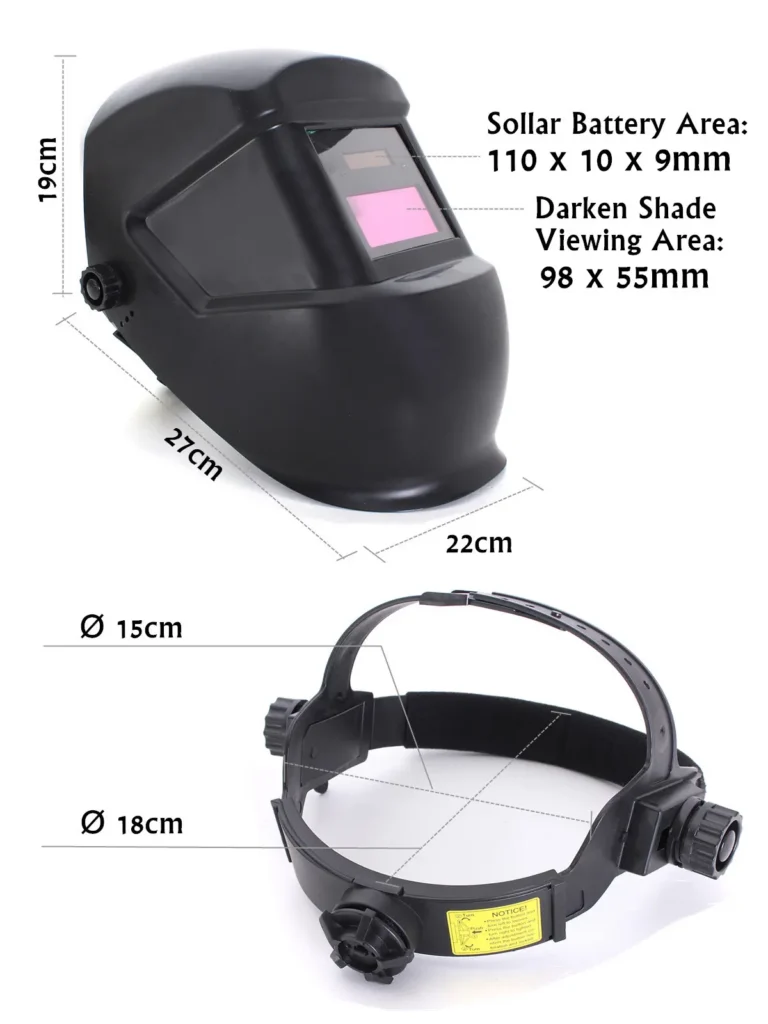Auto-darkening welding helmets are essential personal protective equipment (PPE) used to protect welders from harmful UV/IR radiation, sparks, and debris while offering a clearer view of the welding process. Here’s a detailed explanation of the standard, use instructions, and key details regarding auto-darkening welding helmets:

1. Standards and Specifications
- Safety Standards: Auto-darkening helmets must meet certain safety regulations like ANSI Z87.1 (USA), EN379 (Europe), or similar standards specific to your country. These standards ensure that the helmet offers adequate protection against UV/IR radiation even when the auto-darkening feature is inactive.
EN 379 is the European standard that specifies the requirements for auto-darkening welding filters used in welding helmets. It ensures the safety and performance of auto-darkening filters (ADF) in terms of light transmission, switching speed, UV/IR protection, and more. Here is a detailed explanation:
EN 379 Standard Overview
EN 379 defines the criteria for automatic welding filters, covering aspects such as:
- Optical Classification: The optical clarity of auto-darkening lenses is rated using a four-number code:
- Optical Class (First Number): Assesses how clear and distortion-free the view is.
- Diffusion of Light (Second Number): Measures the amount of light scattering, impacting visibility.
- Variations in Luminous Transmittance (Third Number): Evaluates how consistent the shade is across the entire viewing area.
- Angle Dependence of Luminous Transmittance (Fourth Number): Checks how shade consistency changes when viewed from different angles.
- Switching Speed: EN 379 dictates how quickly the filter must respond when the welding arc is struck. This switching speed is usually in milliseconds or microseconds, like 1/25,000th of a second. The faster the response, the better the protection against sudden exposure to intense light.
- UV/IR Protection: Auto-darkening filters under EN 379 must provide constant protection from harmful UV and IR radiation, even in their inactive (light) state. This ensures that your eyes are always protected, whether the helmet is actively darkening or not.
- Shade Levels: EN 379 defines the shade ranges that welding filters can provide:
- Variable Shade (DIN 5-13): Covers a range of welding types and brightness levels.
- Fixed Shade: Some filters offer a single shade level, commonly used for specific welding processes.
- Light Transmittance: EN 379 tests the uniformity of light transmission across the viewing area, ensuring consistent shade levels without distortions or bright spots.
- Resistance to Impact and Heat: The standard includes testing for durability against mechanical impacts, high temperatures, and resistance to surface damage, ensuring long-term reliability.
Classification Code Example (1/1/1/1):
- 1st Number (Optical Class): Clarity and distortion-free view.
- 2nd Number (Diffusion of Light): Light scattering inside the lens.
- 3rd Number (Luminous Transmittance Variation): Consistency of the shade across the lens.
- 4th Number (Angle Dependence): Consistency of the shade when viewed at an angle.
A 1/1/1/1 rating is the best possible score, indicating top optical performance.
- Shade Levels: The lens typically has variable shade levels, ranging from DIN 5 to DIN 13. The resting state (when not welding) is usually a light shade (DIN 3 or 4) for better visibility. When the arc is struck, the lens automatically darkens to the selected level based on the welding type (MIG, TIG, Stick, etc.).
2. Components and Features
- Auto-Darkening Filter (ADF): The ADF contains light sensors and a liquid crystal display (LCD) that darkens when it detects the welding arc. The switching speed (reaction time) is often measured in milliseconds (e.g., 1/25,000th of a second).
- Sensitivity Adjustment: This feature allows you to adjust the helmet’s sensitivity to different light levels, making it versatile for various welding environments.
- Delay Control: This setting controls how long the lens stays dark after the welding arc stops. A shorter delay is suitable for high-speed tasks, while a longer delay is better for processes generating persistent bright afterglow.
- Grind Mode: Some helmets have a grind mode, which disables auto-darkening so that the helmet can be used for grinding without the lens constantly activating.
3. Instructions for Use
- Pre-Inspection:
- Check the helmet for any cracks, damage, or wear before use.
- Inspect the lens and ensure it is clean and free from dust or smudges.
- Ensure the battery is charged (if applicable) and test the auto-darkening feature by exposing it to a bright light source.
- Adjustment and Fit:
- Headband/Strap Adjustment: Adjust the helmet’s headband for a snug and comfortable fit. Ensure the helmet can be flipped up or down easily without becoming loose.
- Lens Settings: Set the shade level based on your welding application. Use the chart usually provided on the helmet or in the user manual as a guide.
- Welding Operation:
- Ensure the helmet is set to the correct mode (weld, grind, etc.).
- Position the helmet in the down position before starting the arc. The auto-darkening feature will activate once the arc is struck.
- If welding in different environments (indoor, outdoor, low light), adjust the sensitivity and delay controls accordingly.
- Post-Use:
- After finishing, clean the helmet lens using a soft cloth to avoid scratches.
- Store the helmet in a dry and dust-free environment to extend its life.
4. Key Considerations When Choosing an Auto-Darkening Welding Helmet
- Lens Quality: Look for helmets with 1/1/1/1 optical clarity rating for the best visibility.
- Comfort: Choose a helmet with an ergonomic design and cushioned headgear, especially for long working hours.
- Weight: Lighter helmets reduce neck strain and fatigue.
- Power Source: Some helmets are solar-powered, while others have replaceable or rechargeable batteries.
- Price vs. Features: Higher-priced helmets usually have more features like grind mode, wider shade range, and better optical clarity, so consider what suits your needs best.
Auto-darkening welding helmets enhance safety and convenience, allowing welders to work more efficiently while minimizing the need for constant adjustments. Proper use and maintenance ensure long-lasting performance and safety.

